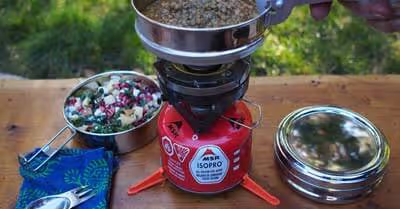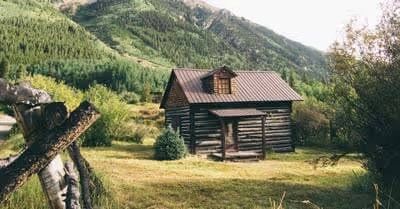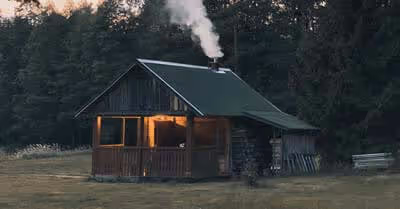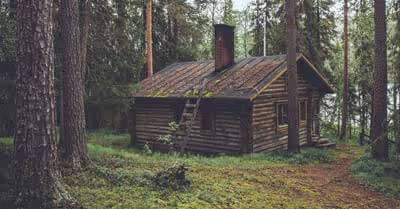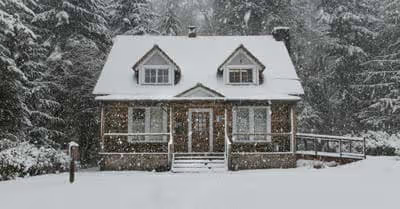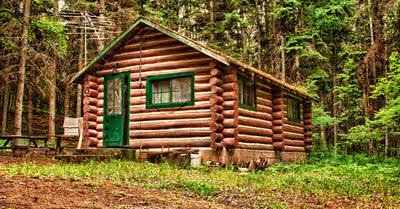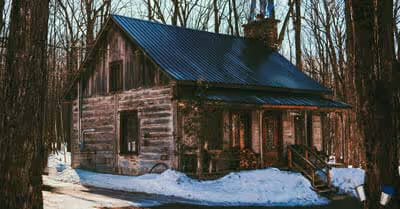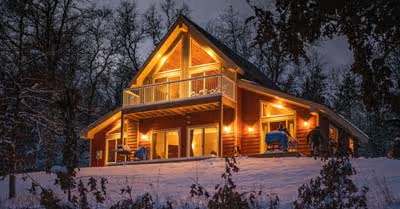Table of Contents
The Best Wood Species for a Log Cabin Building
When it comes to selecting which wood to use, it can be hard to figure out which is the best species. Also, where the wood was grown and what time of year it was cut will play into how dense and dry a log is, determining whether they will be prone to cracking and mold. The best types of wood are grown at high altitudes and felled during the winter when the sap content of the wood is low.
You want to make sure that whatever supplier you are purchasing from pays attention to these details. There are many types of wood to choose from; however, western red cedar and douglas fir are considered some of the best for log buildings. They provide strength, consistency, and are less likely to crack as they dry.
The western red cedar often has flared ends that are used to enhance the look of outside walls. The price will vary somewhat for wood logs that have these kinds of flared ends. Below are some of the other popular wood species used for wood cabins.
- Pine
- Cypress
- Spruce
- Hemlock
- Oak
- Poplar
Of all the available options, pine, poplar, and cedars are the most used in America due to easy accessibility and more affordable price ranges. They all are good choices as long as you make sure that you purchase from conscientious distributors and retailers who have ensured the wood was sourced at a good time and place.
There are also several ways that logs are prepared for sale. They can be kiln dried or air dried, and this is the step that will determine whether a log is going to be prone to cracking or not. One reason it is recommended to fell trees during winter and colder months is due to less sap in the wood, which makes drying faster.
The pros and cons of air-dried versus kiln-dried are pretty straightforward. Kiln-dried wood takes more energy and is thus less environmentally friendly. They are also much more expensive, so you will want to avoid them if you are on a strict budget.
You can find out more information on which wood species are best for construction using online resources like Log Home where you can find specific information on individual types of trees and their uses.
How Much Does it Cost to Get Logs?
Buying From a Manufacturer
Hardwood manufacturing companies like Midwest Hardwood Corporation can be found in almost any state though there tend to be more in the NorthWestern United States. These companies have locations where they air and kiln dry full-length logs for building cabins, cut them to standardized specifications, and sell them to retailers or individuals.
Most logging companies only deal with sawmills instead of individual clients because it is more cost-effective. This means that one of the cheapest options (aside from cutting down trees on your property) involves getting logs directly from a mill. They usually offer various sizes, wood types, and cuts.
Buying From an Online Resource
Nowadays, you can buy anything online. Logs for your cabin are no exception. However, a note of caution, it is much easier for online suppliers to give false credentials so always look up the company and make sure they are legitimate before purchasing anything.
Many sites that offer multiple purchasing options. One is Merrimac Quality Log Homes, where they prefabricated cabin kits, logs, and assistance with planning your cabin build. Their log cabin industry experts are there to help you decide which is best for your budget and desired result.
That particular site features a comprehensive lumber price list, an extensive inventory of ready to assemble kits, and they have a reliable association membership. While they have professionals prepared to help you figure out the best wood and cut for your project, Merrimac Quality Log Homes also provide almost every building accessory needed to complete your log home. Also, their prefabricated kits are 100% ready to be stacked and screwed.
This is just one out of thousands of online options. If you find one local to your area, they will sometimes have on-site assistance available at an extra cost to help with the installation and set up process. If you are looking for a small, idyllic cabin, then Battle Creek Log Homes has some excellent kit options.
Below are several of their popular packages to give you an idea of the cost for kits from several different suppliers.
Trapper Cabin (Battle Creek Log Homes)
- 946 Square Feet
- 2 Bed | 1 Bath
- Standard Package: $54,356
Mountaineer Cabin (Coventry Log Homes)
- 567 Square Feet
- 2 Bed | 1 Bath
- Pre-cut Log Package:$22,950
- Shell Package: $30,750
- Complete Package: $43,950
Mountain King (Conestoga Log Cabins and Homes)
- 1,080 Square Feet
- 2 Bed | 1 Bath
- Standard Kit: $61,900
No matter what route you go, there will be a significant difference between prices depending on the type of wood and cut you are buying and who you purchase it from. Generally, buying directly from a mill will be cheaper, but that does not take into account other things like floor plans, hiring builders, and engineers. All of which will not be necessary if you get pre-made kits that simply need to be assembled.
Buying Wholesale and Local
Most local companies that offer log building kits and wholesale wood stock can be found through your local business directories or online. You can also check for any sawmills in your area as they tend to have lower prices. The downside to going straight to a mill instead of a company set up to help you design and build your cabin is that you will not have the same professional guidance.
Even if you do not have any local businesses that offer these services, wholesale log buying is still one of the cheapest options available. You can always buy from sellers online. We have listed a few of them below and their going rate.
Log Siding (Wholesale Logs America)
- $2.29 per foot
Log Siding (Wholesale Log Homes)
- $4.75 kiln dried, per foot
The average is going to be around $3 per foot.
Deciding on the Look of Your Log Cabin
For aesthetic and design reasons, you may want to get various cuts of wood for your building. You will need to figure out which ones give a look that you want for your railings, siding, stairs, corners, etc. which all have their own unique attraction. The price will vary depending on which of these you buy and whether or not you are purchasing from a wholesale distributor.
Milled Logs
For a uniform look, you will want to use milled logs that have been machine cut to be a consistent size. This makes it easier to slot the pieces together and creates a more polished overall look.
Natural Cut Logs
You can always simply plane each log to make sure that they fit together snugly where they meet and leave the rest of the log mostly natural-looking. Some wood like western red cedar has flared ends as well. You can use these rougher looking logs to give your cabin a feeling of being older and rustic.
Corners and Special Cuts
One area of the design that is going to create the most significant visual impact is the corners. You will want to make sure that you find a distributor that has the corner cut that you want at an affordable price. Below are just a few of the individual cuts that most wholesalers and retailers provide.
- Special Cuts
- Navajo
- Cuda
- Blind male-female
- Corner Cuts
- Saddle Notch
- Butt and Pass
- Cornerpost
- Dovetail
- Mortise and Tenon
Log Siding
You can get wood for your cabin siding, which can come as quarter, half, or whole logs. This is one area where you can save some money if you choose to get half or quarter log siding. These also make installation of wood siding on a home built of other materials much easier to install.
Pros and Cons of Purchasing a Log Cabin Kit
There is a massive market for premade log cabin kits that you can buy and then either set up yourself or some packages come with on-site assistance. Whether you are looking to build a full-scribe traditional log cabin or something more modern, there is a kit for you.
Pros
- Prefabricated log homes come with the benefit of stamped blueprints and an engineer sign off on the construction
- They are easy and fast to put together
- There are hundreds of suppliers and designs to choose from, and each one has multiple package options
- Most aspects of the building process are covered under the kit, so it saves a lot of time, footwork, and effort on your part
Cons
- These can be quite a bit more expensive per square foot than most other options
- Because there are so many options, it is essential not to get taken in by a less reputable supplier. Always check credentials
- If a price seems too good to be true, then it probably is, and you should look elsewhere
There are a few other things to consider if you buy a cabin kit. Make sure the supplier is registered with a reliable association, both their logs and design blueprints are stamped, and they should offer significant warranty coverage. If you cannot find any information on these, then try looking for a kit with a different company.
Getting Logs From Your Property
This option comes with its own price tag, even if you do all the work yourself. There will still be a significant amount of time spent finding the right trees, feeling them, and turning them into good logs for building. However, if you have enough forested acreage, then this might be the right option for you and your budget.
You will want to find a reliable source of information regarding how to determine which trees to cut down and how to do so safely. There is also the option of paying a professional to come in and take care of it for you. Depending on where you live and what species of wood live on your land, this might be the cheapest option.
There is some great information about building cabins using trees on your land at Log Cabin Hub which includes how to select the right trees and different safety measure you would need to employ. There is also an endless number of online tutorials, videos, books, and other resources for using your trees for lumber.
Felling Your Trees
You will not only need to worry about felling the trees, but also consider the time that it will take to decrease the moisture content in the logs to the point where they can then be used for building purposes. You may be able to kiln your logs through a local business, but there will still be a wait time, so you will not be ready to start building immediately.
There are also things like permits and renting the necessary equipment for felling and then moving the trees that you cut down from the area where they are grown to wherever you plan to start building. This may be one of the cheapest options overall, but it will involve much more planning, time, and hard work.
Ultimately, it can be a significant confidence boost to know that you were personally responsible for every step of the creation process for your new home. It is something you can be proud of and show off to your friends and family. The time and dedication needed to log your land for materials can be challenging but rewarding.
Recent Articles



